Submitted:
12 October 2023
Posted:
16 October 2023
Read the latest preprint version here
Abstract
Keywords:
1. Introduction
2. Material and Methods
2.1. Study Area
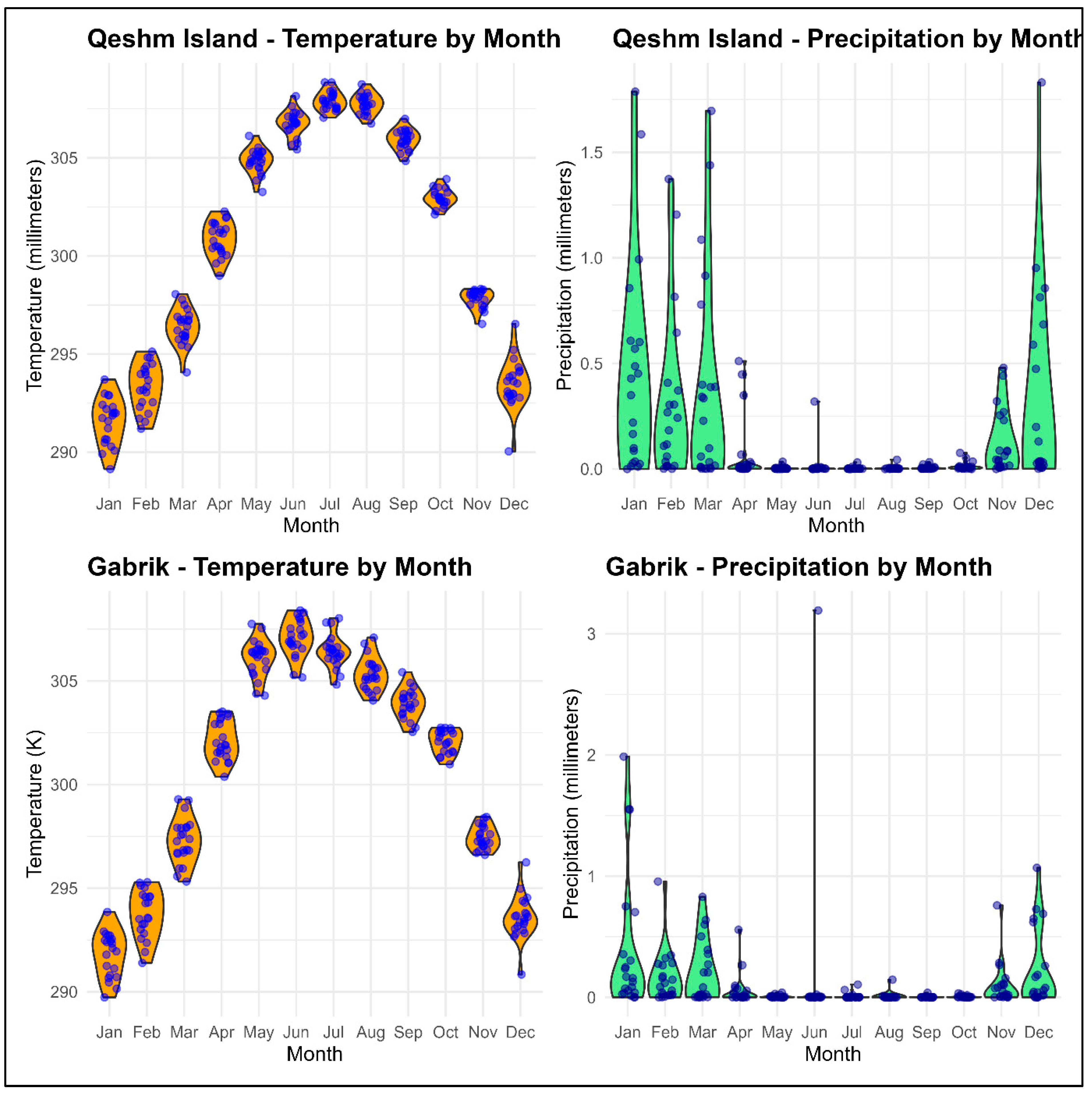
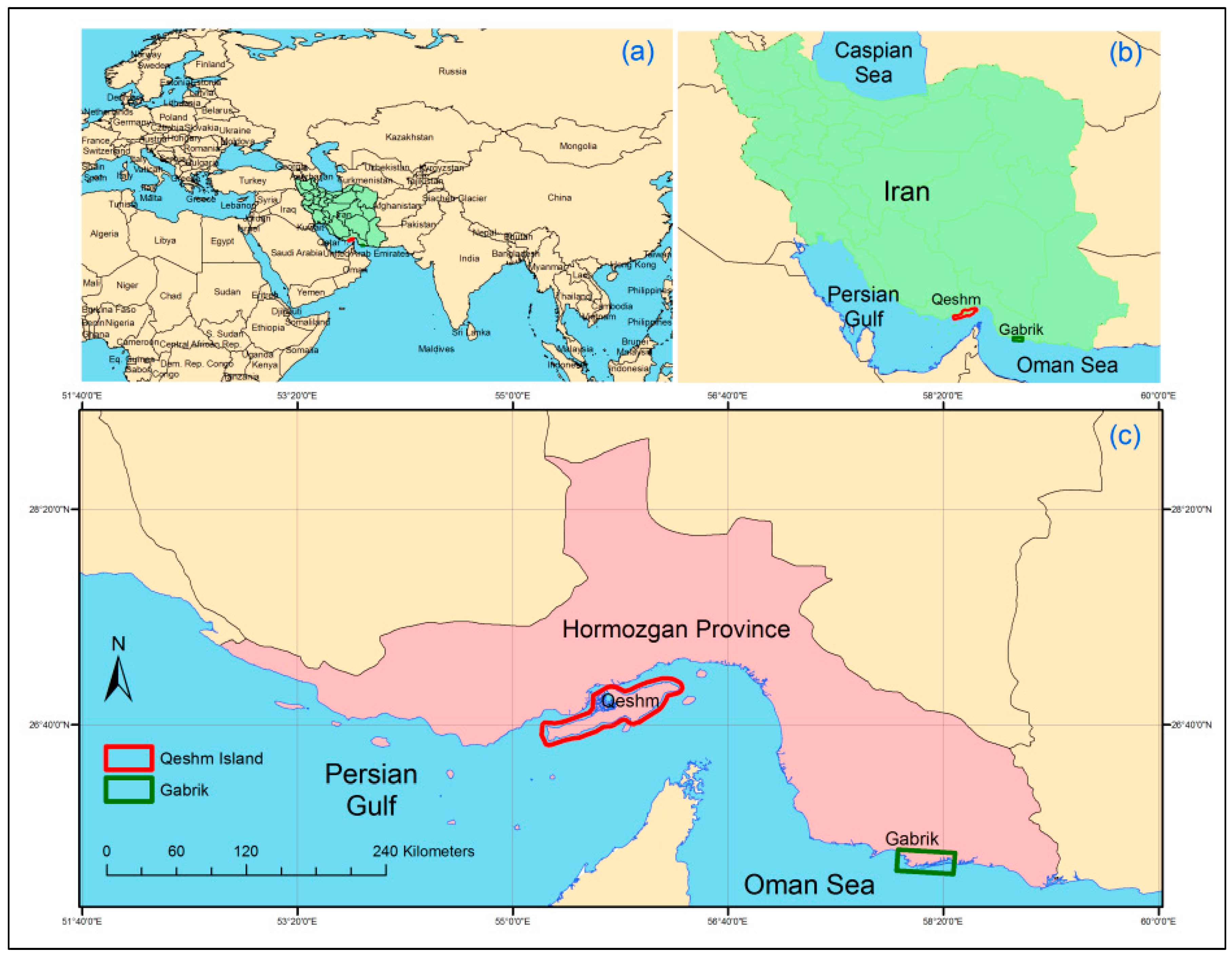
2.2. Materials and data collection
2.2.1. State variables
2.2.2. Map of mangrove Forest ecosystems and land-use and land cover-change
2.3. Methods for exploring early warning signals of critical transition
3. Results
3.1. land-use and land cover-change
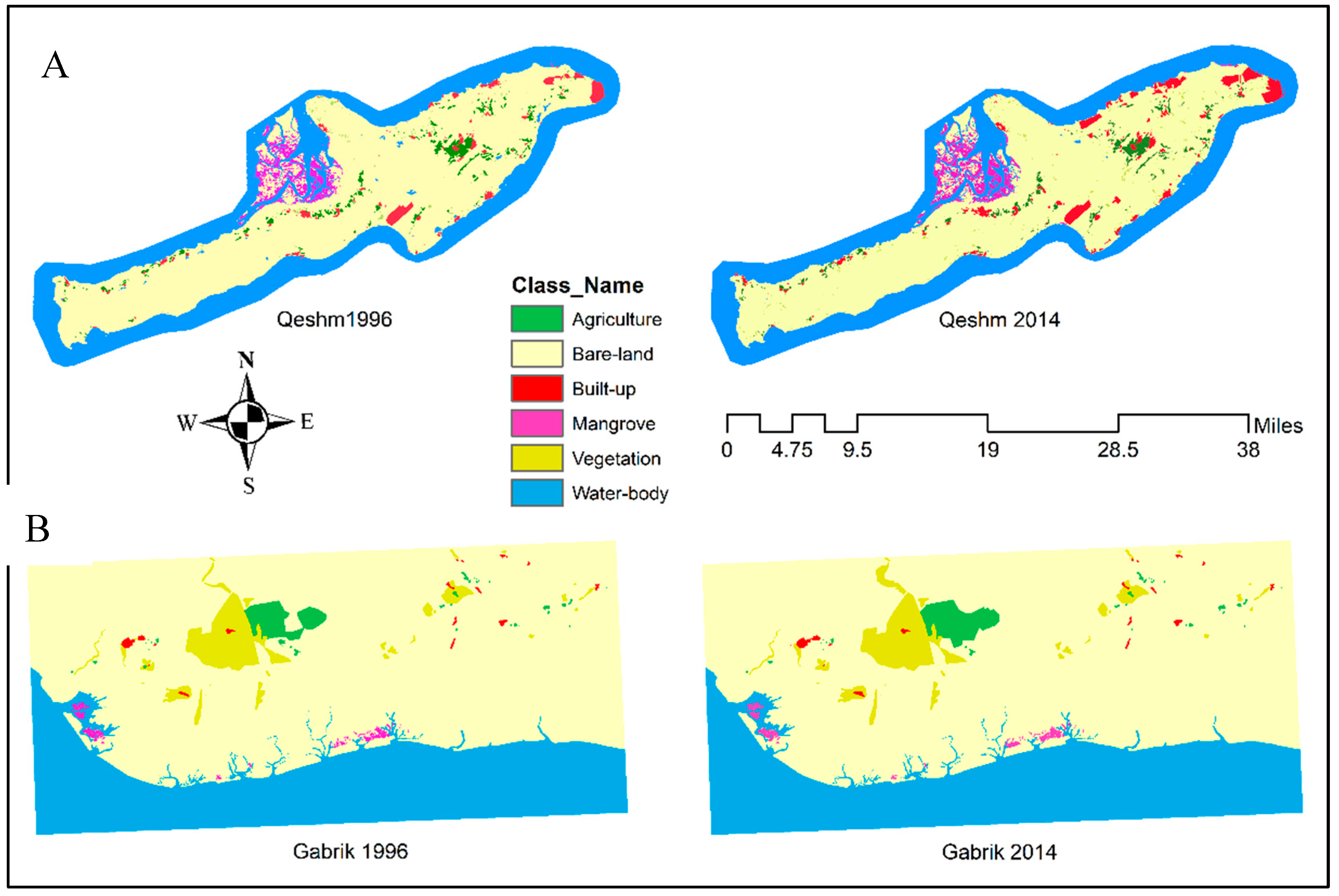
3.2. Time series of state variables
3.3. Early warning signals of a critical transition
4. Discussion
5. Conclusion
References
- Abrantes, K. G., R. Johnston, R. M. Connolly and M. Sheaves (2015). “Importance of mangrove carbon for aquatic food webs in wet–dry tropical estuaries.” Estuaries and Coasts 38: 383-399. [CrossRef]
- Alatorre, L. C., S. Sánchez-Carrillo, S. Miramontes-Beltrán, R. J. Medina, M. E. Torres-Olave, L. C. Bravo, L. C. Wiebe, A. Granados, D. K. Adams and E. Sánchez (2016). “Temporal changes of NDVI for qualitative environmental assessment of mangroves: shrimp farming impact on the health decline of the arid mangroves in the Gulf of California (1990–2010).” Journal of Arid Environments 125: 98-109. [CrossRef]
- Alibakhshi, S. (2020). Remotely sensed monitoring of land surface albedo and ecosystem dynamics. Department of Built Environment, Aalto University.
- Alibakhshi, S. (2023). A robust approach and analytical tool for identifying early warning signals of forest mortality, Ecological Indicators. 155. [CrossRef]
- Alibakhshi, S., T. A. Groen, M. Rautiainen and B. Naimi (2017). “Remotely-sensed early warning signals of a critical transition in a wetland ecosystem.” Remote Sensing 9(4): 352-352. [CrossRef]
- Barbier, E. B., E. W. Koch, B. R. Silliman, S. D. Hacker, E. Wolanski, J. Primavera, E. F. Granek, S. Polasky, S. Aswani and L. A. Cramer (2008). “Coastal ecosystem-based management with nonlinear ecological functions and values.” science 319(5861): 321-323. [CrossRef]
- Bevan, J. M. and M. G. Kendall (1971). “Rank Correlation Methods.” The Statistician 20(3): 74-74.
- Cabello, K., M. Germentil, A. Blanco, E. Macatulad and S. Salmo III (2021). “Post-Disaster Assessment of Mangrove Forest Recovery in Lawaan-Balangiga, Eastern Samar Using Ndvi Time Series Analysis.” ISPRS Annals of the Photogrammetry, Remote Sensing and Spatial Information Sciences 3: 243-250.
- Capon, S. J., A. J. J. Lynch, N. Bond, B. C. Chessman, J. Davis, N. Davidson, M. Finlayson, P. A. Gell, D. Hohnberg and C. Humphrey (2015). “Regime shifts, thresholds and multiple stable states in freshwater ecosystems; a critical appraisal of the evidence.” Science of the Total Environment 534: 122-130. [CrossRef]
- Carpenter, S. R. and W. A. Brock (2006). “Rising variance: A leading indicator of ecological transition.” Ecology Letters 9(3): 311-318. [CrossRef]
- Carpenter, S. R. and W. A. Brock (2011). “Early warnings of unknown nonlinear shifts: A nonparametric approach.” Ecology 92(12): 2196-2201. [CrossRef]
- Carpenter, S. R., W. A. Brock, J. J. Cole, J. F. Kitchell and M. L. Pace (2008). “Leading indicators of trophic cascades.” Ecology Letters 11(2): 128-138. [CrossRef]
- Carpenter, S. R., J. J. Cole, M. L. Pace, R. Batt, W. A. Brock, T. Cline, J. Coloso, J. R. Hodgson, J. F. Kitchell, D. A. Seekell, L. Smith and B. Weidel (2011). “Early warnings of regime shifts: A whole-ecosystem experiment.” Science 332(6033): 1079-1082. [CrossRef]
- Chen, Y., C. Huang, C. Ticehurst, L. Merrin and P. Thew (2013). “An evaluation of MODIS daily and 8-day composite products for floodplain and wetland inundation mapping.” Wetlands 33(5): 823-835. [CrossRef]
- Dahdouh-Guebas, F., L. P. Jayatissa, D. Di Nitto, J. O. Bosire, D. L. Seen and N. Koedam (2005). “How effective were mangroves as a defence against the recent tsunami?” Current biology 15(12): R443-R447.
- Dakos, V., S. R. Carpenter, W. A. Brock, A. M. Ellison, V. Guttal, A. R. Ives, S. Kéfi, V. Livina, D. A. Seekell, E. H. van Nes and M. Scheffer (2012). “Methods for detecting early warnings of critical transitions in time series illustrated using simulated ecological data.” PLoS ONE 7(7): e41010-e41010. [CrossRef]
- Dakos, V., S. R. Carpenter, E. H. van Nes and M. Scheffer (2015). “Resilience indicators: Prospects and limitations for early warnings of regime shifts.” Philosophical Transactions of the Royal Society B: Biological Sciences 370(1659): 1-10.
- Dakos, V., E. H. Van Nes, P. D’Odorico and M. Scheffer (2012). “Robustness of variance and autocorrelation as indicators of critical slowing down.” Ecology 93(2): 264-271. [CrossRef]
- Daru, B. H., K. Yessoufou, L. T. Mankga and T. J. Davies (2013). “A global trend towards the loss of evolutionarily unique species in mangrove ecosystems.” PloS one 8(6): e66686. [CrossRef]
- Duke, N. C., J.-O. Meynecke, S. Dittmann, A. M. Ellison, K. Anger, U. Berger, S. Cannicci, K. Diele, K. C. Ewel and C. D. Field (2007). “A world without mangroves?” Science 317(5834): 41-42.
- Ebrahimi-Sirizi, Z. and A. Riyahi-Bakhtiyari (2013). “Petroleum pollution in mangrove forests sediments from Qeshm Island and Khamir Port—Persian Gulf, Iran.” Environmental monitoring and assessment 185: 4019-4032. [CrossRef]
- Ellison, A. M. (2008). “Managing mangroves with benthic biodiversity in mind: moving beyond roving banditry.” Journal of Sea Research 59(1-2): 2-15. [CrossRef]
- Eslami-Andergoli, L., P. E. R. Dale, J. M. Knight and H. McCallum (2015). Approaching tipping points: a focussed review of indicators and relevance to managing intertidal ecosystems. Wetlands Ecology and Management, Kluwer Academic Publishers. 23: 791-802. [CrossRef]
- Giri, C., E. Ochieng, L. Tieszen, Z. Zhu, A. Singh, T. Loveland, J. Masek and N. Duke (2013). “Global mangrove forests distribution, 2000.” NASA Socioeconomic Data and Applications Center (SEDAC), Palisades. https://doi.org/10: H4J67DW68.
- Giri, C., E. Ochieng, L. L. Tieszen, Z. Zhu, A. Singh, T. Loveland, J. Masek and N. Duke (2011). “Status and distribution of mangrove forests of the world using earth observation satellite data.” Global Ecology and Biogeography 20(1): 154-159. [CrossRef]
- Goldberg, L., D. Lagomasino, N. Thomas and T. Fatoyinbo (2020). “Global declines in human-driven mangrove loss.” Global change biology 26(10): 5844-5855.
- Gorelick, N., M. Hancher, M. Dixon, S. Ilyushchenko, D. Thau and R. Moore (2017). “Google Earth Engine: Planetary-scale geospatial analysis for everyone.” Remote Sensing of Environment 202: 18-27. [CrossRef]
- Guttal, V. and C. Jayaprakash (2008). “Changing skewness: An early warning signal of regime shifts in ecosystems.” Ecology Letters 11(5): 450-460. [CrossRef]
- Hirota, M., M. Holmgren, E. H. Van Nes and M. Scheffer (2011). “Global resilience of tropical forest and savanna to critical transitions.” Science 334(6053): 232-235. [CrossRef]
- Ji, L., L. Zhang and B. Wylie (2009). “Analysis of dynamic thresholds for the normalized difference water index.” Photogrammetric Engineering and Remote Sensing 75(11): 1307-1317. [CrossRef]
- Kathiresan, K. (2012). “Importance of mangrove ecosystem.” International Journal of Marine Science 2(10).
- Kéfi, S., V. Guttal, W. A. Brock, S. R. Carpenter, A. M. Ellison, V. N. Livina, D. A. Seekell, M. Scheffer, E. H. Van Nes and V. Dakos (2014). “Earl y warning signals of ecological transitions: Methods for spatial patterns.” PLoS ONE 9(3): e92097-e92097. [CrossRef]
- Kirui, K., J. G. Kairo, J. Bosire, K. M. Viergever, S. Rudra, M. Huxham and R. A. Briers (2013). “Mapping of mangrove forest land cover change along the Kenya coastline using Landsat imagery.” Ocean & Coastal Management 83: 19-24. [CrossRef]
- Kourosh Niya, A., J. Huang, H. Karimi, H. Keshtkar and B. Naimi (2019). “Use of intensity analysis to characterize land use/cover change in the biggest Island of Persian Gulf, Qeshm Island, Iran.” Sustainability 11(16): 4396.
- Lenton, T. M. (2011). “Early warning of climate tipping points.” Nature Climate Change 1(4): 201-209. [CrossRef]
- Lenton, T. M., H. Held, E. Kriegler, J. W. Hall, W. Lucht, S. Rahmstorf and H. J. Schellnhuber (2008). “Tipping elements in the Earth’s climate system.” Proceedings of the National Academy of Sciences of the United States of America 105(6): 1786-1793.
- Lenton, T. M., V. N. Livina, V. Dakos, E. H. Van Nes and M. Scheffer (2012). “Early warning of climate tipping points from critical slowing down: Comparing methods to improve robustness.” Philosophical Transactions of the Royal Society A: Mathematical, Physical and Engineering Sciences 370(1962): 1185-1204. [CrossRef]
- Li, H., M. Jia, R. Zhang, Y. Ren and X. Wen (2019). “Incorporating the plant phenological trajectory into mangrove species mapping with dense time series Sentinel-2 imagery and the Google Earth Engine platform.” Remote Sensing 11(21): 2479. [CrossRef]
- Li, W., Q. Chen, D. Cai and R. Li (2015). “Determination of an appropriate ecological hydrograph for a rare fish species using an improved fish habitat suitability model introducing landscape ecology index.” Ecological Modelling 311: 31-38. [CrossRef]
- Lugendo, B. R., I. Nagelkerken, G. Kruitwagen, G. Van Der Velde and Y. D. Mgaya (2007). “Relative importance of mangroves as feeding habitats for fishes: a comparison between mangrove habitats with different settings.” Bulletin of Marine Science 80(3): 497-512.
- Luther, D. A. and R. Greenberg (2009). “Mangroves: a global perspective on the evolution and conservation of their terrestrial vertebrates.” BioScience 59(7): 602-612. [CrossRef]
- Martínez, M. L., A. Intralawan, G. Vázquez, O. Pérez-Maqueo, P. Sutton and R. Landgrave (2007). “The coasts of our world: Ecological, economic and social importance.” Ecological economics 63(2-3): 254-272.
- Mazraeh, H. M. and M. Pazhouhanfar (2018). “Effects of vernacular architecture structure on urban sustainability case study: Qeshm Island, Iran.” Frontiers of architectural research 7(1): 11-24. [CrossRef]
- Mozumder, C., N. K. Tripathi and T. Tipdecho (2014). “Ecosystem evaluation (1989–2012) of Ramsar wetland Deepor Beel using satellite-derived indices.” Environmental Monitoring and Assessment 186(11): 7909-7927. [CrossRef]
- Muñoz Sabater, J. (2019). “ERA5-land monthly averaged data from 1981 to present, Copernicus Climate Change Service (C3S) Climate Data Store (CDS).” Earth Syst. Sci. Data 55: 5679-5695.
- Naderloo, R., M. Türkay and A. Sari (2013). “Intertidal habitats and decapod (Crustacea) diversity of Qeshm Island, a biodiversity hotspot within the Persian Gulf.” Marine biodiversity 43: 445-462.
- Nagelkerken, I., G. Van der Velde, M. Gorissen, G. Meijer, T. Van’t Hof and C. Den Hartog (2000). “Importance of mangroves, seagrass beds and the shallow coral reef as a nursery for important coral reef fishes, using a visual census technique.” Estuarine, coastal and shelf science 51(1): 31-44.
- Pinheiro, J., D. Bates, S. DebRoy and D. Sarkar (2000). “the R Development Core Team, 2013.” NLME: linear and nonlinear mixed effects models: 1-3.
- Polidoro, B. A., K. E. Carpenter, L. Collins, N. C. Duke, A. M. Ellison, J. C. Ellison, E. J. Farnsworth, E. S. Fernando, K. Kathiresan and N. E. Koedam (2010). “The loss of species: mangrove extinction risk and geographic areas of global concern.” PloS one 5(4): e10095. [CrossRef]
- Qgis, S. (2016). QGIS Geographic Information System v.2.16.3. Open Source Geospatial Foundation. URL: http://qgis.osgeo.org.
- Rokni, K., A. Ahmad, A. Selamat and S. Hazini (2014). “Water feature extraction and change detection using multitemporal landsat imagery.” Remote Sensing 6(5): 4173-4189. [CrossRef]
- Ruan, L., M. Yan, L. Zhang, X. Fan and H. Yang (2022). “Spatial-temporal NDVI pattern of global mangroves: A growing trend during 2000–2018.” Science of The Total Environment 844: 157075. [CrossRef]
- Scheffer, M. (1990). Multiplicity of stable states in freshwater systems. Hydrobiologia, Springer. 200-201: 475-486. [CrossRef]
- Scheffer, M. (2001). “Alternative attractors of shallow lakes.” TheScientificWorldJournal 1: 254-263. [CrossRef]
- Scheffer, M., J. Bascompte, W. A. Brock, V. Brovkin, S. R. Carpenter, V. Dakos, H. Held, E. H. Van Nes, M. Rietkerk and G. Sugihara (2009). “Early-warning signals for critical transitions.” Nature 461(7260): 53-59. [CrossRef]
- Scheffer, M., S. Carpenter, J. A. Foley, C. Folke and B. Walker (2001). “Catastrophic shifts in ecosystems.” Nature 413(6856): 591-596. [CrossRef]
- Shimu, S. A., M. Aktar, M. I. Afjal, A. M. Nitu, M. P. Uddin and M. Al Mamun (2019). NDVI based change detection in Sundarban Mangrove Forest using remote sensing data. 2019 4th International Conference on Electrical Information and Communication Technology (EICT), IEEE.
- Sorichetta, A., G. M. Hornby, F. R. Stevens, A. E. Gaughan, C. Linard and A. J. Tatem (2015). “High-resolution gridded population datasets for Latin America and the Caribbean in 2010, 2015, and 2020.” Scientific data 2(1): 1-12. [CrossRef]
- Tajbakhsh, A., A. Karimi and A. Zhang (2020). “Modeling land cover change dynamic using a hybrid model approach in Qeshm Island, Southern Iran.” Environmental monitoring and assessment 192: 1-17.
- Tehrani, N. A. and M. Janalipour (2021). “Predicting ecosystem shift in a Salt Lake by using remote sensing indicators and spatial statistics methods (case study: Lake Urmia basin).” Environmental Engineering Research 26(4). [CrossRef]
- Toosi, N. B., A. R. Soffianian, S. Fakheran, S. Pourmanafi, C. Ginzler and L. T. Waser (2019). “Comparing different classification algorithms for monitoring mangrove cover changes in southern Iran.” Global Ecology and Conservation 19: e00662. [CrossRef]
- Tran, T. V., R. Reef and X. Zhu (2022). “A Review of Spectral Indices for Mangrove Remote Sensing.” Remote Sensing 14(19): 4868. [CrossRef]
- Verbesselt, J., R. Hyndman, G. Newnham and D. Culvenor (2010). “Detecting trend and seasonal changes in satellite image time series.” Remote Sensing of Environment 114(1): 106-115. [CrossRef]
- Verbesselt, J., R. Hyndman, A. Zeileis and D. Culvenor (2010). “Phenological change detection while accounting for abrupt and gradual trends in satellite image time series.” Remote Sensing of Environment 114(12): 2970-2980. [CrossRef]
- Verbesselt, J., N. Umlauf, M. Hirota, M. Holmgren, E. H. Van Nes, M. Herold, A. Zeileis and M. Scheffer (2016). “Remotely sensed resilience of tropical forests.” Nature Climate Change 6(11): 1028-1031. [CrossRef]
- Wang, F., J. Zhang, Y. Cao, R. Wang, G. Kattel, D. He and W. You (2023). “Pattern changes and early risk warning of Spartina alterniflora invasion: a study of mangrove-dominated wetlands in northeastern Fujian, China.” Journal of Forestry Research: 1-16. [CrossRef]
- Xu, H. (2006). “Modification of normalised difference water index (NDWI) to enhance open water features in remotely sensed imagery.” International Journal of Remote Sensing 27(14): 3025-3033. [CrossRef]
- Yessoufou, K. and G. Stoffberg (2016). “Biogeography, threats and phylogenetic structure of mangrove forest globally and in South Africa: A review.” South African Journal of Botany 107: 114-120. [CrossRef]
- Zahed, M. A., F. Rouhani, S. Mohajeri, F. Bateni and L. Mohajeri (2010). “An overview of Iranian mangrove ecosystems, northern part of the Persian Gulf and Oman Sea.” Acta Ecologica Sinica 30(4): 240-244. [CrossRef]
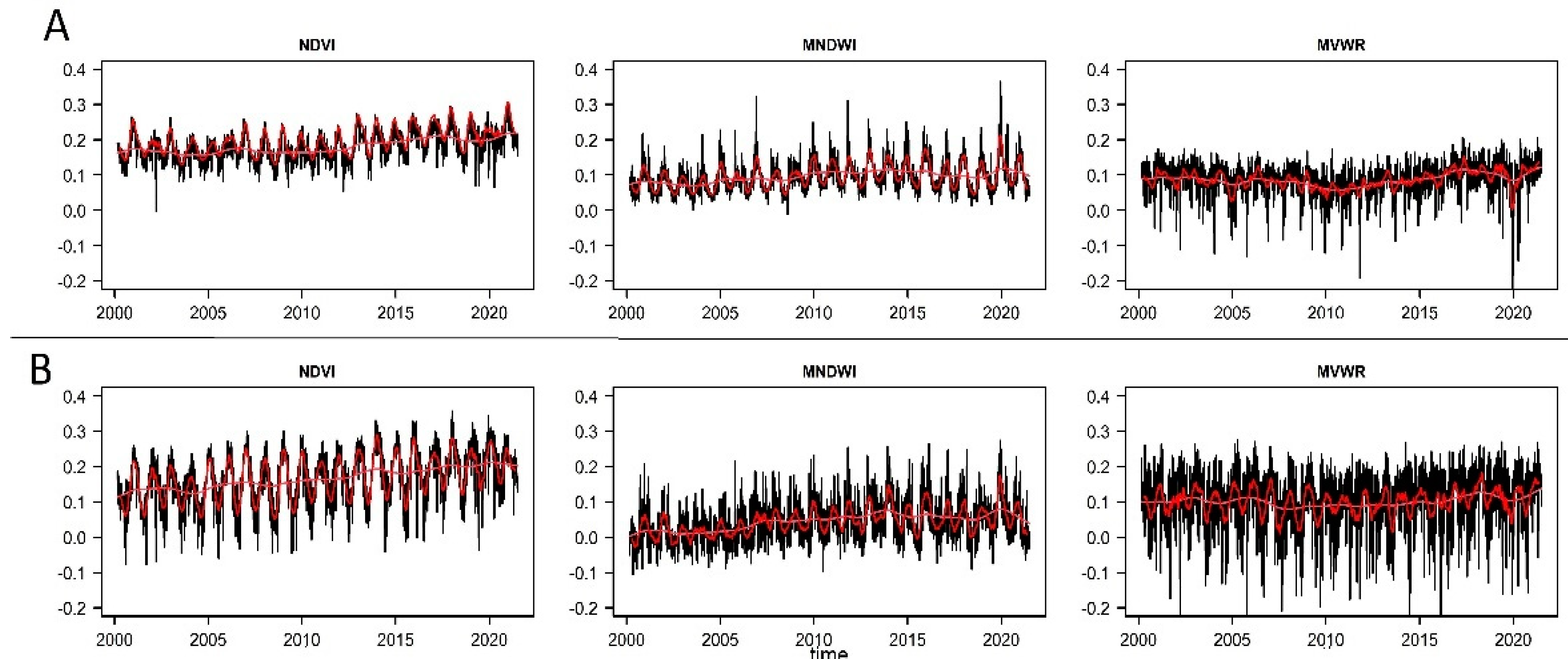
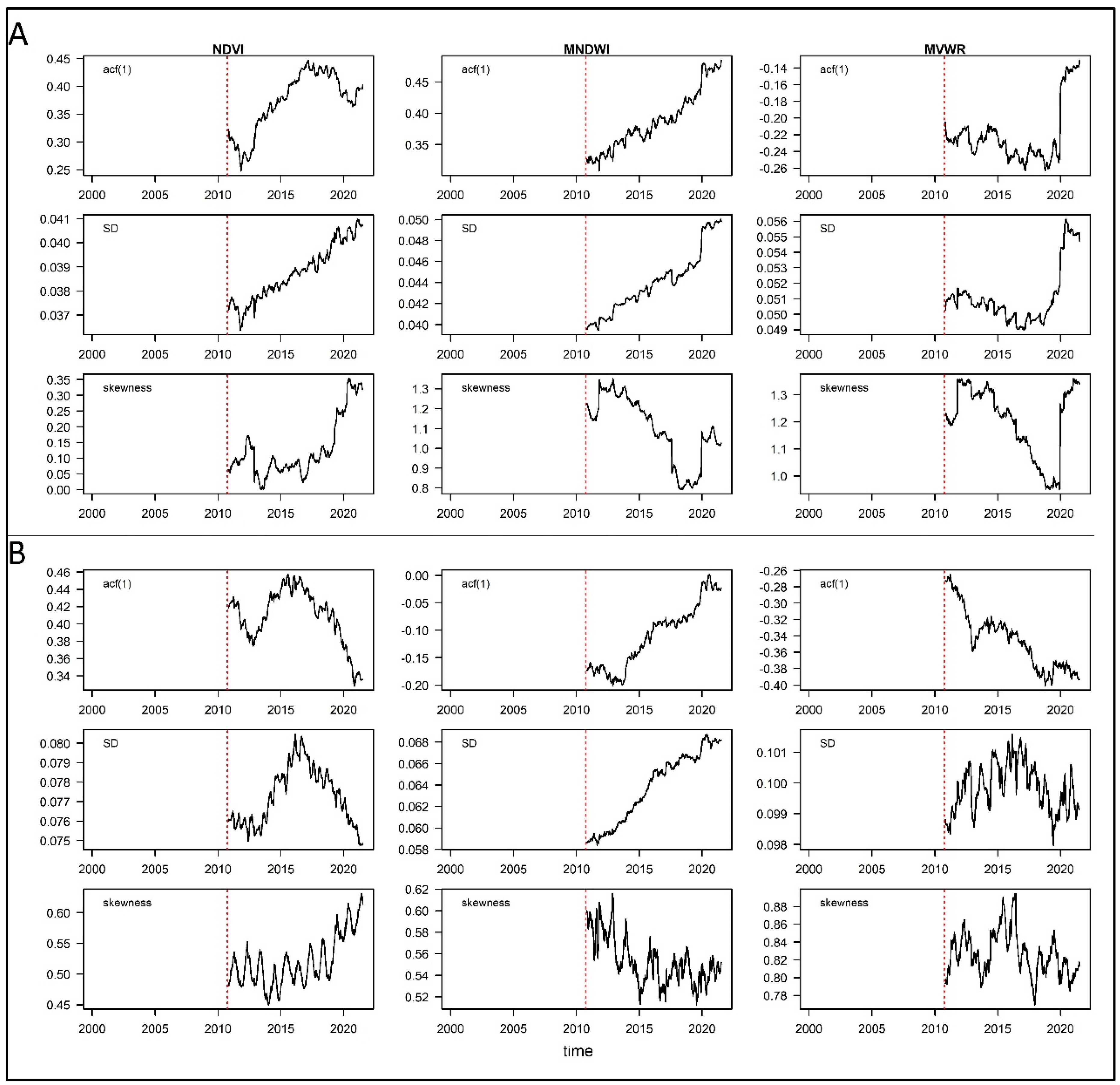
| Case study | Class | 1996 (number of pixels) | 2014 (number of pixels) | Change (number of pixels) | Percentage (%) |
|---|---|---|---|---|---|
| Qeshm | Agriculture | 51615 | 51953 | 338 | 0.65% |
| Bare-land | 1571765 | 1514405 | -57360 | -3.65% | |
| Built-up | 55525 | 91284 | 35759 | 64.40% | |
| Mangrove | 66672 | 73552 | 6049 | 9.07% | |
| Vegetation | 9787 | 15836 | 6880 | 70.30% | |
| Water-body | 1012778 | 1021114 | 8336 | 0.82% | |
| Gabrik | Agriculture | 30929 | 35637 | 4708 | 15.22% |
| Bare-land | 1674507 | 1665878 | -8629 | -0.52% | |
| Built-up | 5317 | 5532 | 215 | 4.04% | |
| Mangrove | 8342 | 9132 | 790 | 9.47% | |
| Vegetation | 81579 | 84207 | 2628 | 3.22% | |
| Water-body | 657401 | 657689 | 288 | 0.04% |
| Statistical Measures | Qeshm | Gabrik | ||||
|---|---|---|---|---|---|---|
| NDVI | MNDWI | MVWR | NDVI | MNDWI | MVWR | |
| Autocorrelation | 0.411 | 0.817 | 0.181 | 0.037 | -0.046 | 0.004 |
| Standard Deviation | 0.535 | 0.827 | -0.207 | -0.689 | 0.652 | -0.483 |
| Skewness | 0.631 | 0.401 | -0.271 | -0.199 | -0.191 | 0.07 |
Disclaimer/Publisher’s Note: The statements, opinions and data contained in all publications are solely those of the individual author(s) and contributor(s) and not of MDPI and/or the editor(s). MDPI and/or the editor(s) disclaim responsibility for any injury to people or property resulting from any ideas, methods, instructions or products referred to in the content. |
© 2023 by the authors. Licensee MDPI, Basel, Switzerland. This article is an open access article distributed under the terms and conditions of the Creative Commons Attribution (CC BY) license (http://creativecommons.org/licenses/by/4.0/).





